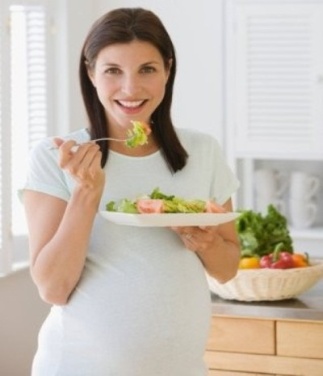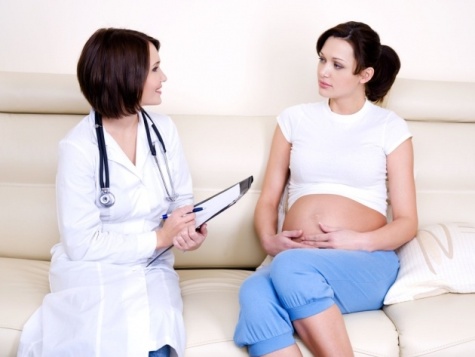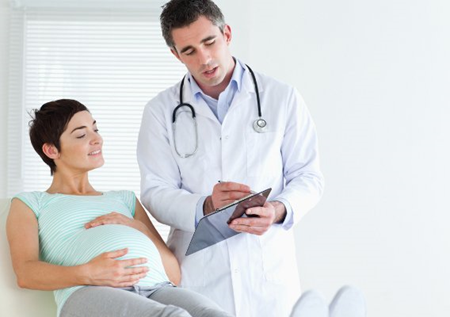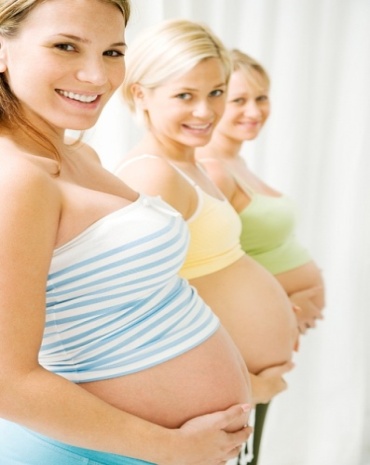ВУЗ: Не указан
Категория: Не указан
Дисциплина: Не указана
Добавлен: 03.12.2023
Просмотров: 265
Скачиваний: 1
ВНИМАНИЕ! Если данный файл нарушает Ваши авторские права, то обязательно сообщите нам.
-
Read and translate the text.
Calories.
Protein, minerals, vitamins.

During pregnancy the total caloric needs increase to supply energy for fetal development. A pregnant woman needs approximately 300 more calories per day than before she becomes pregnant. It may be a little less during the first trimester and a little more in the last. Woman carrying twins will need even more.
The extra 300 calories can come from an apple, half a cheese sandwich and a carrot stick. The best way to consume extra calories is healthy snacks eaten between meals.
Protein is a component of every body cell and important for building the maternal blood supply. Protein also is necessary for fetal hair, skin, muscle, nerve tissue and brain development. Women need approximately 10 more grams of protein daily – a total of 60 grams a day – during the pregnancy.
Minerals. Calcium and phosphorus are important minerals in fetal-bone development; a pregnant woman requires 1.200 mg of calcium and phosphorus daily. This is a 50 increase over what a woman needed before she became pregnant.
Dairy products are excellent sources of calcium and phosphorus, as well as vitamin D which is necessary for calcium absorption.
Zinc is another mineral needed for fetal growth and development. Good food sources of zinc include meat, liver, eggs, seafood.
Iron builds maternal blood volume and fetal blood and muscles. Many women enter pregnancy with low iron stores, resulting in anaemia. Food rich in iron include red meat, especially liver, raisins and fortified breads and cereals.
Vitamins. Folic acid is a vitamin important in protein metabolism, particularly in periods of rapid growth. Pregnant woman should start the day with a good breakfast. Fortified ready-to eats cereal with milk and a glass of orange juice will provide at least half needs. Green leafy vegetables, liver and lentils are other goodsources of folic acid.
Vocabulary.
-
Translate these words and word combinations from Russian into English.
Потребности в калориях повышаются, ежедневно, немного меньше, немного больше, двойня, дополнительные 300 калорий, полбутерброда с сыром, лучший способ получить дополнительные калории, здоровая еда, между приемом пищи, каждая клетка тела, развитие мозга до беременности, молочные продукты, кальций, фосфор, низкое содержание железа, анемия, начинать день, листовые овощи, фолиевая кислота.
-
Complete the sentences with words from the list.
approximately
body cell
excellent
twins
pregnancy
folic acid
-
A pregnant woman needs ___________ 300 more calories per day than before she become pregnant. -
Woman carrying __________ will need even more. -
Protein is a component of every _____________ and important for building the maternal blood supply. -
Dairy products are ___________ sources of both calcium and phosphorus. -
Many women enter ____________ with low iron stores. -
Green leafy vegetables, liver are good sources of ____________
Unit 3. Vitamins. A visit to gynecologist.
Body bits.
-
Complete the descriptions of vitamins, minerals and oils with the words below. Some words are used more than once.
 teeth
teethbrain
blood
cells
skin
organs
eyes
muscles
enzymes
immune system
cardiovascular system
nervous system
bones
Vitamin A keeps the _____________healthy and is important for good vision. It is found in fatty foods like butter, cheese, whole milk and yoghurt.
The B-vitaminsstrengthen the ___________ and help reduce stress. They are found in foods like wholegrain bread and cereals.
Vitamin C is needed to help the ___________ repair itself when it is cut or damaged. It is found in fruit, especially citrus fruit like oranges and grapefruit.
Vitamin D is needed for healthy bones and __________, protects against rickets because it helps the body absorb calcium. Our body makes vitamin D when our __________ is exposed to sunlight.
Calcium is needed for children’s ___________ and teeth to grow. It is found in foods like milk, cheese andyoghurt.
Iron helps you ___________ carry oxygen. If you do not get enough iron, you will be pale and tired and you may get anaemia. Iron is found in red meat, especially liver.
Zinc makes your __________ stronger so that you can fight colds and infections. It is found in shellfish, nuts and seeds.
Omega- 3 is an essential fatty acid which helps your __________ function well. It is found in oily fish like mackerel, sardines, salmon and tuna.
Protein builds up, maintains and replaces the tissues in your body. Your _______, your ___________and your immune system are made up mostly of protein.
Carbohydrates are sugars which are broken down by ___________ then stored in the ___________ as a source of energy. Grain products such as rice, bread and pasta are sources of carbohydrate.
Fats fuel the body and help absorb some vitamins. They are also the building blocks of hormones and they insulate nervous system tissue in the body. Unsaturated fats, found in oils and nuts, for example, are believed to protect the ____________.
Grammar

-
Complete the conversation with the words below.
-
Go to Grammar reference.
‘d
better
may
oughtn’t
should
try
| Nurse | Any problems, Marian? |
| Marian | I had a bit of bleeding after my aerobics class. I thought maybe I’d ___________ stop exercising. |
| Nurse | Well, it’s a good idea to exercise, but you __________ to do aerobics if it causes bleeding. You ____________ want to try swimming, or something gentle like that. |
| Marian | I know. I ___________ buy myself a swimming costume. Another thing is, I can’t get comfortable at night. |
| Nurse | __________ putting a pillow underneath you – that should help. |
| | |
| Marian | OK – I’ll try that. I’m also a bit worried about these stretch marks on my tummy. |
| Nurse | I _________ rub cream or oil into it – that’s very good for stretch marks. |
| Marian | Oh, right. I’ll get some today. |
Reading.
-
Read and translate the dialogue.
A visit to a gynecologist.

| Doctor: | What is the matter with you? Do you have any complains? |
| Patient: | Yes, there is something wrong with me and I think that I am pregnant. |
| Doctor: | Are you married? |
| Patient: | Yes, I am. |
| Doctor: | Is this your first pregnancy and have you ever performed abortion? |
| Patient: | I have never performed abortion and I have a child. My son is 7 years old. |
| Doctor: | How did your previous pregnancy proceed? Did you feel well throughout the whole pregnancy? |
| Patient: | My previous pregnancy was uneventful. |
| Doctor: | How did you feel in the first half of pregnancy? Did you have any toxemia or nausea? |
| Patient: | Yes, I had. And I have the same symptoms now. Usually they are the true signs of pregnancy. |
| Doctor: | Do you and your husband want to have any more children? |
| Patient: | Yes, we dream about daughter. But I am afraid that it can be complicated pregnancy. |
| Doctor: | Was your previous delivery premature or at term? |
| Patient: | At term, but I was younger then. |
| Doctor: | And how old are you now? |
| Patient: | I am twenty-nine. |
| Doctor: | I think, that you are healthy enough to have the second child and that you will not have a threatened miscarriage. I hope that everything will be all right. |
Signs and symptoms.
Pregnancy and labor

-
A pattern of signs often alerts a woman that she may be pregnant. A different pattern of signs occurs when labor begins at the end of pregnancy. Work in pairs to complete the list of signs using the words below. Decide if each sign indicates pregnancy or labor. Write P (pregnancy) or L (labor)
bloating
contractions
discharge
fatigue
mood
morning
mucus
need
nipple
pelvis
rupture
strength
temperature
trembling
| 1. | You will miss a menstrual period. | __P_ |
| 2. | False ___________ occur. | ____ |
| 3. | __________ and sleepiness are common. | ____ |
| 4. | Contractions become more rhythmic and increase in _________. | ____ |
| 5. | Some women feel abdominal __________. | ____ |
| 6. | ________ swings and stress are often reported. | ____ |
| 7. | You notice an increase in pink or white _________. | ____ |
| 8. | You may experience ________ sickness. | ____ |
| 9. | Your basal body ________ will be elevated. | ____ |
| 10. | There may be a “show”, which is the release of a ________ plug from the cervix. | ____ |
| 11. | You may feel the _________ to urinate frequently. | ____ |
| 12. | The baby’s head engages – that is, lowers into the _________. | ____ |
| 13. | It is common for the area around the _________ to darken. | ____ |
| 14. | Shivering or _________ without reason is common. | ____ |
| 15. | Your waters break, which is the _________of the amniotic sac. | ____ |
Writing.
-
Read the essay on the advantages and disadvantages of water birth. Write the letter of the paragraph where the writer makes each point below. Put a cross (х) if the point is not included in the essay.
| 1. | Nurses have a great risk of infection with water birth. | _C_ |
| 2. | Water birth is becoming more widely available. | ____ |
| 3. | The mother’s anxiety is reduced in water. | ____ |
| 4. | Water births cause delays if emergency treatment is needed. | ____ |
| 5. | Women who have given birth in water often choose to again. | ____ |
| 6. | There is a risk of the baby breathing water into its lungs. | ____ |
| 7. | Bleeding is difficult to monitor. | ____ |
| 8. | The mother can change position more easily in water. | ____ |
W
A
ater birth is becoming increasingly popular and more and more hospitals are making this option available to women. However, it is important for women to be aware that there are potential problems as well as benefits before opting for a water birth.
T
B
he main benefit of a water birth is that it makes labour more comfortable. It is easier for the woman to move around, which gives her a feeling of control and therefore makes her feel more relaxed and less anxious. The reduced pain of water birth also lowers anxiety. For this reason, being in water lowers the blood pressure, which avoids a range of complications.
O
C
n the negative side, it is difficult to monitor the woman accurately during a water birth, so it is not suitable for high-risk pregnancies. Also, it is easier for waterborne pathogens to be transferred from mother to baby – or to medical staff. In addition to this, although being in water reduces the mother’s pain, it can also weaken the contractions. Another drawback is the risk of hypothermia unless water temperature is carefully monitored. Finally, the risk of heavy blood loss is increased in water, as bleeding is difficult to measure underwater.
D
Despite these disadvantages, both patients and medical staff are very positive about water birth and many women opt to do it again for subsequent children. With more training and facilities, the limitations of water birth could be reduced.
1 2 3
TASKS FOR STUDENT’S INDEPENDENT WORK
-
Write an essay of 200-250 words with the title “The advantages and disadvantages of home birth”. Write the essay in four sections, as in example.
-
Introduction -
Advantages -
Disadvantages -
Conclusion
-
Research two of the following substances; write and tell the other students about why pregnant woman needs them and what they are found in.
-
Vitamin E -
Vitamin K -
Potassium -
Folic acid
-
Choose one of the conditions below. Research and present in class how it is caused or transmitted, and its effects on foetus or newborn baby.
-
syphilis -
HIV
GRAMMAR REFERENCE
We can use a variety of expressions to give advice. These include modal verbs such as ought to and should + infinitive. Both convey strong and / or urgent advice, and there is no difference in meaning between them.
| Positive | You ought to / should take folic acid every day in early pregnancy. |
| Negative | You oughtn’t to/ shouldn’t smoke. |
Another way of giving strong advice is you’d better (not)+ infinitive.
If you start bleeding, you’d better see your doctor straight away.
You’d better not lift heavy objects when pregnant.
Other expressions that are less strong include:
-
You may want to + infinitive
You may want to avoid strenuous activity.
-
It’s (always) a good idea (not) to +infinitive
It’s always a good idea to have a balanced diet.
It’s always a good idea not to get too stressed.
-
Try (not)+infinitive with to
Try to drink lots of fluids.
Try not to push until I tell you.
-
I’d + infinitive
We often useI’dto give more personal advice. It means If I were in your position.It is common to add if I were you at the end of the clause.
I’d cut down on caffeine if I were you.
We use must / mustn’t and have to / don’t have to to talk about obligation, when giving rules or telling someone what to do or what not to do.
Nurses must use an antimicrobial agent.
Nurses mustn’t wear make-up.
We use have to/ has to + infinitive in positive sentences and questions to talk about things that we are obliged to do because of the circumstances or because someone tells us to.
Visitors have to leave the ward by 20.00.
We use don’t have to / doesn’t have to + infinitive to talk about actions that are not necessary.
Nurses don’t have to clean the floor. That is the job of the cleaners.
We use need(s) to + infinitive to say that an action is necessary. We use don’t / doesn’t need to in a similar way to don’t / doesn’t have to.
We use need + -ing to say what tasks it is necessary to do.
The floorneeds cleaning.
The bedsdon’t need changing.
English-Russian dictionary
Obstetrics – акушерство
Gynecology – гинекология
Pregnancy – беременность
Extrauterine – внематочная
Abortion –аборт; to perform abortion – делать аборт
Contraceptives – противозачаточные средства
Fetus -плод
Labor–роды
Difficult labor – трудные роды
Painless labor – безболезненные роды
Cesarean section – кесарево сечение
Maternity home – родильный дом
Pathology of pregnancy – патология беременности
Toxemia of pregnancy – токсикоз беременных
Amniotic fluid – околоплодные воды
Water bag – плодный пузырь
Rupture of water bag – вскрытие плодного пузыря
Afterbirth – послед
Separation of afterbirth – отделение последа
Umbilical cord –пуповина
Tying of the cord – перевязка пуповины
Cord rupture – разрыв пуповины
Contractions (birth pains) – родовые схватки
Female – женский
Male – мужской
Sterility – бесплодие
Uterine bleeding – маточное кровотечение
Menstrual cycle – менструальный цикл
Climacteric – климакс
Vagina – влагалище
Ovary – яичник
Testicle – яичко
Uterus – матка
Uterine disorder/disease – заболевание матки
Uterine prolapse – опущение матки
Perforation of the uterus – перфорация матки
Uterine rupture – разрыв матки
Uterine cancer – рак матки
Cervix/ uterine neck – шейка матки
Advice – совет, консультация
Avoid – избегать, исключать
Premature – преждевременный, недоношенный
Excitement – волнение
Expectancy – ожидание
Womb – матка, утроб матери
Range – диапазон, пределы
Total – целое, полный, суммарный
Need – нужда, нуждаться, потребность
Supply – обеспечивать, восполнять
Extra – дополнительный
Snack – легкая еда между завтраком, обедом и ужином
Increase – повышать, увеличивать
Protein – белок
Cell – клетка
Maternal – материнский
Nerve tissue – нервная ткань
Brain – мозг
Dairyproducts – молочные продукты
Require – нуждаться, требуется
Source – источник
Absorption – поглощение
Iron –железо
Cereal – злаки, крупа
Substance –вещество, субстанция
Carbohydrate – углевод
Amount – количество
Scurvy – цинга
Strengthen – укреплять, усиливать
Nervous – нервная
Complaint – жалоба
Uneventful – без осложнений
Nausea – тошнота
Premature delivery – преждевременные роды
Delivery at term – своевременные роды
Threatened miscarriage – угрожающий выкидыш
Amniotic sac – околоплодный мешок
Ovum – яйцеклетка
Cell division – деление клетки
Fertilization – оплодотворение
Embryo – эмбрион
Discharge – выделения
Mucus – слизь
Nipple – сосок грудной железы
Pelvis – таз
Mood – настроение
Fatigue – усталость